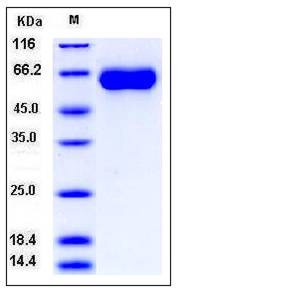Human MGAT5 / GGNT5 Protein (His Tag)
GNT-V,GNT-VA
- 100ug (NPP4083) Please inquiry
| Catalog Number | P11373-H08H |
|---|---|
| Organism Species | Human |
| Host | Human Cells |
| Synonyms | GNT-V,GNT-VA |
| Molecular Weight | The recombinant human MGAT5 consists of 564 amino acids and predictes a molecular mass of 65 kDa. In SDS-PAGE under reducing conditions, the apparent molecular mass of rh MGAT5 is approximately 60-65 kDa. |
| predicted N | Leu 189 |
| SDS-PAGE |  |
| Purity | > 98 % as determined by SDS-PAGE |
| Protein Construction | A DNA sequence encoding the human MGAT5 (NP_002401.1) C-terminal segment (Leu 189-Leu 741) was fused with a polyhistidine tag at the C-terminus and a signal peptide at the terminus. |
| Bio-activity | Measured by its ability to transfer N-Acetyl-α-D-glucosamine from UDP-N-Acetyl-α-D-glucosamine to a biantennary N-linked core pentasaccharide in a CD39L3 coupled assay. The specific activity is >10pmoles/min/μg |
| Research Area | Signaling |Signal Transduction |Cytoskeleton / ECM |Cell Adhesion |Tight Junctions |
| Formulation | Lyophilized from sterile PBS, pH 7.4 1. Normally 5 % - 8 % trehalose, mannitol and 0.01% Tween80 are added as protectants before lyophilization. Specific concentrations are included in the hardcopy of COA. |
| Background | Alpha-1,6-mannosylglycoprotein 6-beta-N-acetylglucosaminyltransferase A, also known as Alpha-mannoside beta-1,6-N-acetylglucosaminyl-transferase, Mannoside acetylglucosaminyltransferase 5, N-acetylglucosaminyl-transferase V, MGAT5 and GGNT5, is a single-pass type I I membrane protein which belongs to the glycosyltransferase 18 family. MGAT5 / GGNT5 catalyzes the addition of N-acetylglucosamine in beta 1-6 linkage to the alpha-linked mannose of biantennary N-linked oligosaccharides. It is one of the most important enzymes involved in the regulation of the biosynthesis of glycoprotein oligosaccharides. The central nervous system (CNS) is rich in glycoconjugates, located on cell surface and in extracellular matrix. MGAT5 / GGNT5 modification of complex-type N-glycans on CNS glycoproteins is involved in the regulation of depression-like behavior. Inhibitors of MGAT5 / GGNT5 might be useful in the treatment of malignancies by targeting their dependency on focal adhesion signaling for growth and metastasis. |
| Reference |
